“No, really, I can’t say I did. He seemed to behave much as any traveler or agent might.”
“Well, what I noticed was the fact that as soon as he entered the place he put his walking-stick into the umbrella-stand over there by the door, close by where he stood, a most unusual thing for a casual caller to do, before even knowing whether you were in. This made me watch him closely. I perceived with increased interest that the stick was exactly of the same kind and pattern as one already standing there, also a curious thing. I kept my eyes carefully on those sticks, and was all the more interested and edified to see, when he left, that he took the other stick—not the one he came with—from the stand, and carried it away, leaving his own behind. I might have followed him, but I decided that more could be learned by staying, as, in fact, proved to be the case. This, by the by, is the stick he carried away with him. I took the liberty of fetching it back from Westminster, because I conceive it to be Ritier’s property.”
Hewitt produced the stick. It was an ordinary, thick Malacca cane, with a buck-horn handle and a silver band. Hewitt bent it across his knee and laid it on the table.
“Yes,” Dixon answered, “that is Ritter’s stick. I think I have often seen it in the stand. But what in the world——”
“One moment; I’ll just fetch the stick Mirsky left behind.” And Hewitt stepped across the corridor.
He returned with another stick, apparently an exact fac-simile of the other, and placed it by the side of the other.
“When your assistants went into the inner room, I carried this stick off for a minute or two. I knew it was not Worsfold’s, because there was an umbrella there with his initial on the handle. Look at this.”
Martin Hewitt gave the handle a twist and rapidly unscrewed it from the top. Then it was seen that the stick was a mere tube of very thin metal, painted to appear like a Malacca cane.
“It was plain at once that this was no Malacca cane—it wouldn’t bend. Inside it I found your tracings, rolled up tightly. You can get a marvelous quantity of thin tracing-paper into a small compass by tight rolling.”
“And this—this was the way they were brought back!” the engineer exclaimed. “I see that clearly. But how did they get away? That’s as mysterious as ever.”
“Not a bit of it! See here. Mirsky gets hold of Ritter, and they agree to get your drawings and photograph them. Ritter is to let his confederate have the drawings, and Mirsky is to bring them back as soon as possible, so that they sha’n’t be missed for a moment. Ritter habitually carries this Malacca cane, and the cunning of Mirsky at once suggests that this tube should be made in outward fac-simile. This morning Mirsky keeps the actual stick, and Ritter comes to the office with the tube. He seizes the first opportunity—probably when you were in this private room, and Worsfold was talking to you from the corridor—to get at the tracings, roll them up tightly, and put them in the tube, putting the tube back into the umbrella-stand. At half-past twelve, or whenever it was, Mirsky turns up for the first time with the actual stick and exchanges them, just as he afterward did when he brought the drawings back.”




